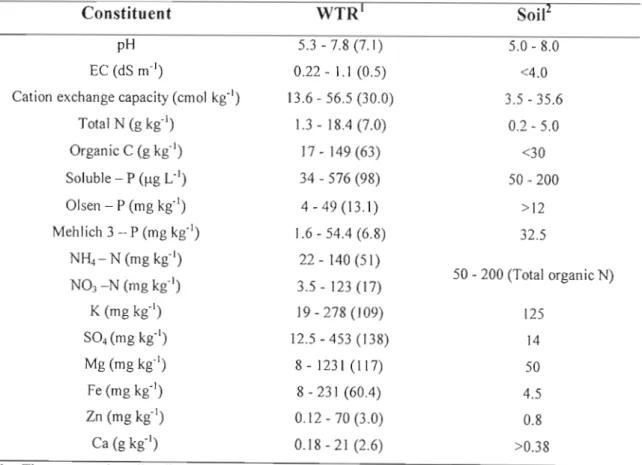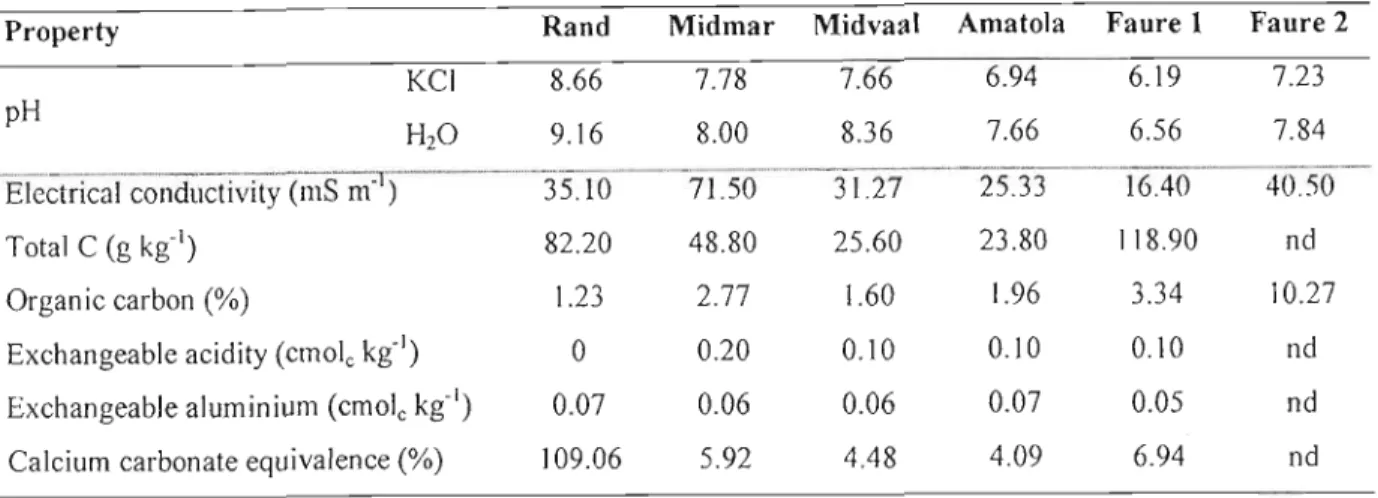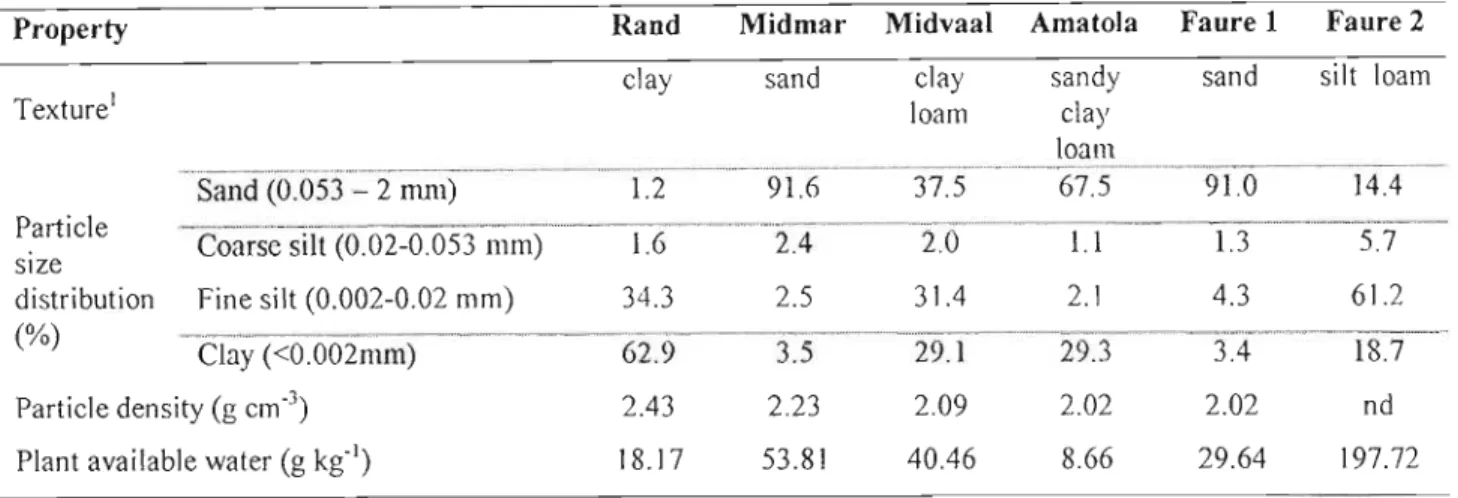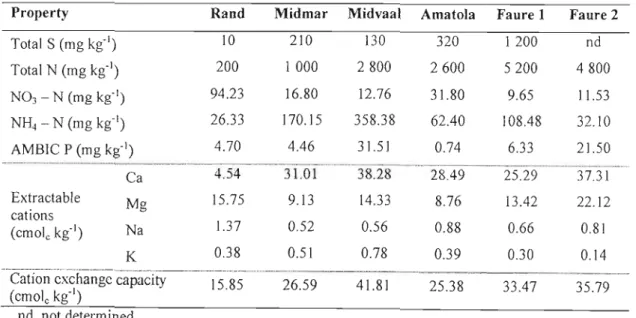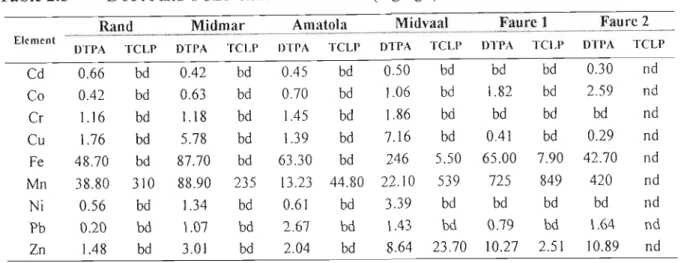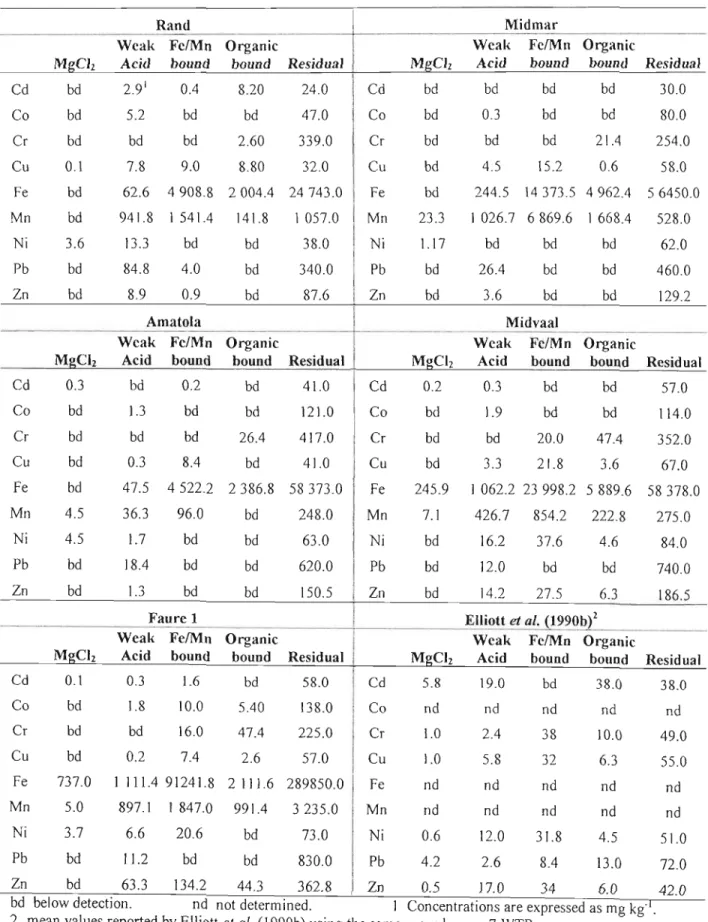Figure 3.3 Average total yields (+SE, 3 replicates) for harvests of Eragrostis tejJ, Digitaria eriantha and Cenchrus ciliaris grown in the soil material treated with Rand water treatment residues at application rates of and 400 g kg". Digitaria eriantha and Cenchrus ciliaris grown in the soil and waste treated with Rand water treatment residues at application quantities of and 400 gkg".
Introduction
The water treatment process and residue production
In short, the choice of flocculant largely depends on the quality of the raw water. The dosages used depend largely on the quality of the raw water (turbidity, odor, hardness, etc.) (CSIR, 1985).
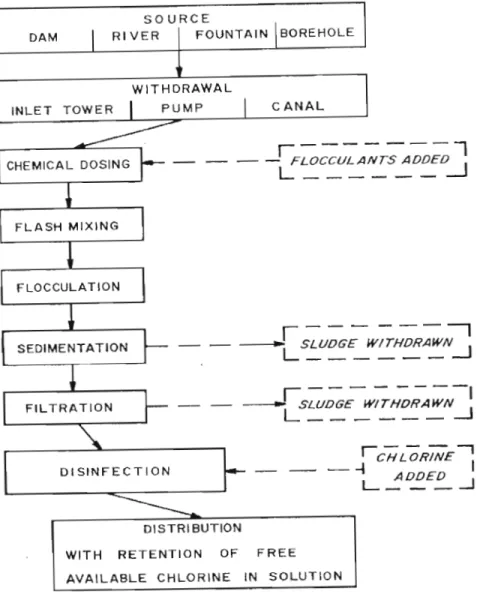
Past disposal practices and current trends
Attention has also been given to the use of WTRs to remove excess nutrients, particularly P, from agricultural soils and nutrient-enriched water bodies (Jonasson, 1996; Cox et al., 1997; Haustein et al., 2000). There has also been a study investigating the use of alum WTR as a component in broilers to reduce NH4+ volatilization, a toxic gas in broiler houses (Maurice et al., 1998).
Properties and characteristics of water treatment residues
The WTRs also exhibited a high water-holding capacity, apparently a function of the high clay content. 1997) present a comprehensive study of the potential of using an alum WTR as a soil conditioner. They reported on the water retention properties (Figure 1.2) of the alum WTR aggregates and concluded that very little change in water holding capacity occurred between -30 and -1500 kPa.
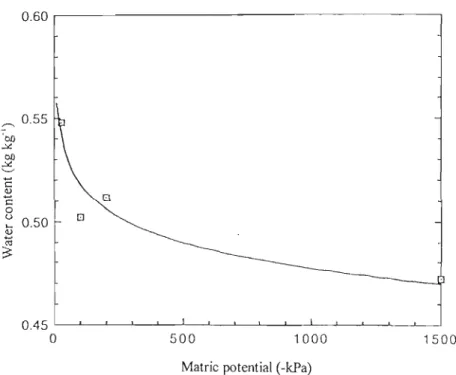
Effec ts on plant g rowth
They found that an addition of 200 mg P kg-I did not increase P availability in WTRs, but increased plant concentrations. This is consistent with the comments of Skene et al. 1997) also found that in the pot experiment, plant tissue P concentrations decreased with increasing WTR application rates, but this was not evident in the field.
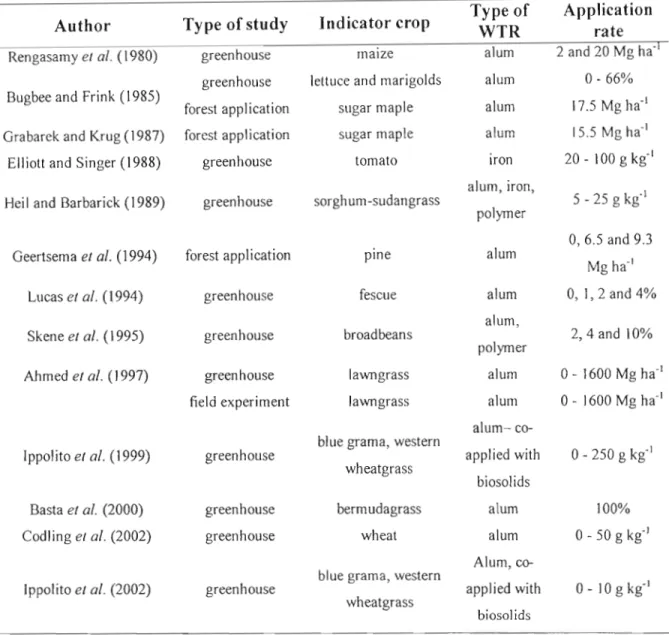
Codisposal with biosolids
They indicate that although concerns about P shortages in the short term are reported, this is unlikely to be a problem in the longer term, especially at the field scale. In the South African context, the generally high P-sorbing capacity of WTRs may be problematic due to the generally low P status of local soils.
Discussion and conclusions
However, it does provide an indication of the range of treatment processes used to produce drinking water in South Africa. The particle size distribution was determined by a modification of the pipette method (Gee and Bauder, 1986; Appendix 3).
Results and discussion
Table 2.3 Some physical characteristics of the water treatment residues from five of South Africa's water treatment facilities. There was also a marked change in the particle size distribution of the Faure WTRs, due to the change in raw water quality and treatment processes. In general, DTPA-extractable metal concentrations were low, with Fe and Mn concentrations elevated in most of the WTRs.
Also notable was the increase in Zn concentration of the Faure 1 WTR and the Pb concentration of the Rand WTR. Lead in these two fractions made up a large proportion of the total for Rand WTR (19.8%). For all the WTRs studied, Fe concentrations were highest in the chromate-extractable fractions (excluding residues), accounting for between 7 and 27% of the total Fe content.
Manganese accounted for a high proportion of the FelMn oxide-bound fraction (2% to 68% of the total Mn concentration).
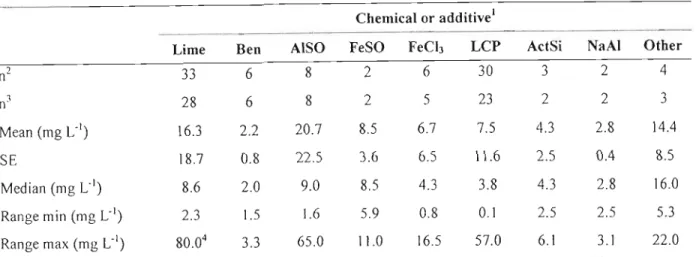
General discussion and conclu sions
Although these values have little significance in practical situations, it indicates the high sorption potential of these residues, suggesting complex interactions with lime, hydro us oxides, organic matter and clay components in WTR, leading to multilayer adsorption and precipitation reactions. In some cases, the high amounts of Mn can lead to toxicity problems (especially the Faure and Midmar WTRs), especially if used under acidic or reducing conditions. It is unlikely that any of the other metals would be problematic. Furthermore, consideration must be given to the amount of soil application as well as existing background soil concentrations and characteristics and the intended purpose of the soil treated with WTR (Elliott et al., 1990a).
As part of the present study, two WTRs were selected for further investigation into their potential for land application. Potential uses of the RWTR included void filling material, a liming material, neutralization of acid hotspots and to improve plant growth. Since the particular interest of the wider project (Introduction) was land application of the WTRs and the effects on soil properties and plant growth, it was decided that laboratory and pot experiments would be used to investigate the latter aspect.
The benefit to the mine would only be realized if the use of RWTR on their materials proved successful and assisted recovery efforts.
Materials and methods
A fine mesh cloth was placed at the bottom of each ring to prevent loss of material. The volume of the rings was calculated and mixtures were added to obtain the same bulk density as the mixtures in the pot experiment. Table 3.2 Some nutrient concentrations of the ash, spoil and soil from the Lethabo Power Station and the New Vaal Colliery. Further weathering of the ash and mortar material can lead to an increase in EC, which can become problematic for plant growth.
The high absorption capacity of the ash can cause serious P deficiencies, especially when mixed with the RWTR. The particle size distribution of the grout was expected as the material was collected as large, coarse fragments. The increase in water retention of the ash due to the addition of RWTR was less noticeable than in the soil and mortar.
The low saturation value of the clean waste material was probably due to the coarse nature of the material.

Pot experiment
The degradation of RWTR can also be partially attributed to the increase in pH with increasing additions of RWTR. The low buffering capacity of the soil resulted in the high pH of the leachate from the RWTR-treated pots. As previously mentioned (Section 3.2.3.2), grass growth in the ash material was very poor (Table 3.1), this aspect of the study was discontinued and consequently no significant data were obtained from the ash-based experiments.
This was reflected in the high standard error values and coefficients of variation (CV) for some treatments (Table 3.7). The second crop showed a slight increase in yield in the control treatment, but a sharp decrease in the RWTR-treated pots. The yield of the control treatment at the third cut decreased substantially, while the remaining treatments (except the 100 and 200 g kg) treatment also decreased from the second cut. This decrease in yield may be due to the fact that the EC increased to a level where seedling growth was stunted.
The poor yields of the first harvest, of the control treatment and low RWTR treatments, may have been due to the seedlings not being able to establish easily in the coarse material.
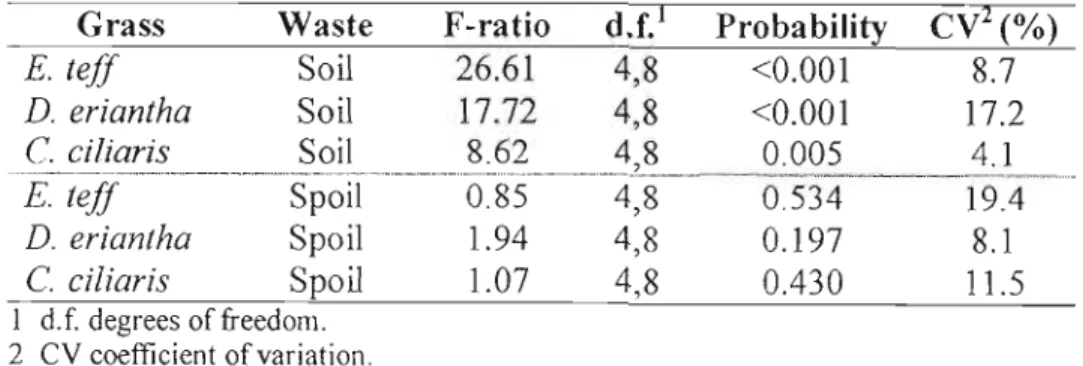
General discussion and conclusions
The same ash and RWTR as described in the previous pot experiment (section 3.2.3) were used, but the RWTR was spread over the ash material (instead of embedded). The size fraction of the RWTR used was slightly larger than before (3.5 mm). The water ring of the pot experiment was the same as described for the previous experiment. The cause of the symptoms has not been determined, but it could be B toxicity (Bennett, 1993), as this is often associated with ash from coal combustion (Carlson and Adriano, 1993).
The root biomass in the ash layers of the treatments where little or no root material was initially established (i.e. 40 and 60 mm RWTR layers) was particularly low and in some cases no roots were found. They reported that yield was low in the control treatments, due to the poor physical properties of the ash. The physical properties of the ash may also have created a physical barrier to root penetration, hence the low yield observed in the present study. soluble).
This was likely due to a partial alleviation of low P availability in the RWTR layer.

Materials and methods
As indicated earlier, the FWTR has shown potential to supply a large number of the nutrients that are deficient in the Lo sand. Although nutrient uptake by the seed was not investigated, they found no toxicity problems caused by trace nutrients in the leaves of the plants. In the case of total number of pods (Table 4.8), the 150% fertilizer treatment (over average FWTR application rate) yielded.
From Figure 4.4, however, it appears that without fertilizer the 400 g kg" FWTR application negatively affects seed production in the bean plant, perhaps due to Mn toxicity and associated antagonistic effects, or possibly a P deficiency considering the high P -sorption capacity of the FWTR (Section 2.3.6). Although there was evidence of Mn toxicity in the leaves of the bean plants, the concentration in the seeds suggests that they will be suitable for consumption. Due to the chlorosis that is visible in the leaves of the bean plants, beans were grown in the 400 g kg" FWTR treatment with a variety of 'enhancing' treatments applied to try to reduce or alleviate the Mn toxicity.
This was partially confirmed by an increase in the Mn concentration of the leachate collected from this experiment (results not shown).
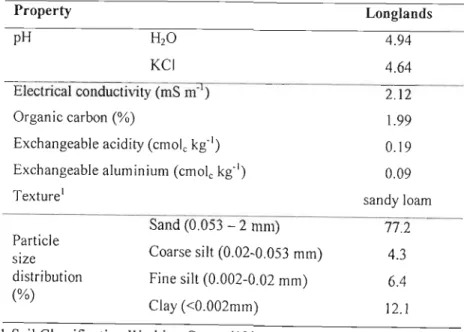
Conclusions
Water was applied to the treatment so that it drained from the base of the pot. A number of problems became apparent as a result of the investigation being conducted as a pot experiment. Application of FWTR to a nutrient-poor soil did not appear to improve bean yield when applied without fertilizer.
Uptake of toxic elements by the seed does not appear to be a problem, but this may not necessarily be the case for other crop species where the fleshy parts and leaves of the crop are consumed (such as tomato or lettuce). An attempt to leach excess Mn from the soil in the FWTR-treated pots appears to temporarily alleviate or reduce the severity of the Mn toxicity. It is likely that under field conditions, with increased leaching, and greater dilution of the FWTR in the soil, the Mn toxicity would not be as severe.
If the intended use is agricultural production, careful consideration must be given to the consequences of the possible introduction of toxic elements into the crops grown.
Further research
The material used here is collected dry, but originated as a slurry from the water treatment process. Evaluation of soil tests to predict bermudagrass growth in drinking water treatment wastes with phosphorus fertilizer. Phosphorus sorption capacity of drinking water treatment wastes and potential for use to protect water quality.
Effect of water treatment sludge on growth and elemental composition of tomato shoots (Lycopersicom esculentum). Use of water treatment residues to reduce nutrient runoff and as an alternative growing medium. Phosphorus availability in soils changed with dewatered water treatment residual and metal concentrations with time in residual.
Laboratory-Physical/Chemical Methods Manual SW- 846, Revision O. Technology transfer manual: waste management of water treatment plants. Beneficial use of potable water treatment waste as a soil substitute in land reclamation. thesis, Oklahoma State University, Stillwater, Oklahoma. The questionnaire was developed prior to the decision to use the term 'water treatment waste', therefore the term 'sludge' was used.
